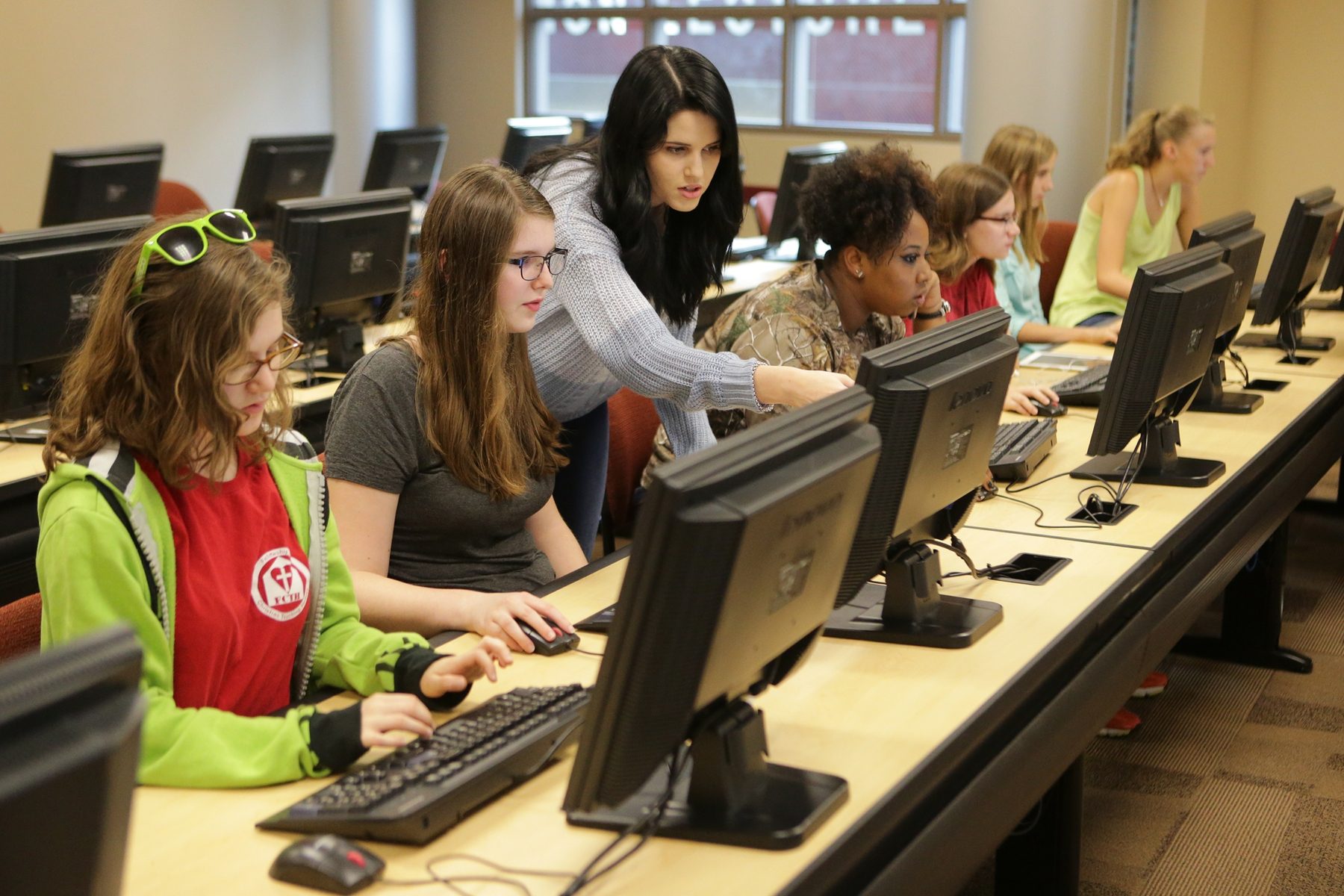November marks exactly a decade since Girls Who Code started with a mission of closing the gender gap in the tech industry. Since its 2012 launch, the organization has served 500,000 girls, women and nonbinary young people globally — half of whom come from Black, Latinx, low-income or other underrepresented groups — via clubs, summer programs and college and career programs in which they meet tech leaders, explore coding and build professional skills.
But the percentage of these individuals entering into the technology profession has dropped steadily over the past several decades. Girls Who Code and the software manufacturer Logitech set out to discover why, issuing a report to identify “What (and Who) Is Holding Women Back in Tech?”
“The problem often is that bias can be both conscious and unconscious,” said Delphine Donné, general manager of personal workspace solutions at Logitech. “Whether it is a parent, a teacher, a coworker or a leader, we need to help them become aware and overcome their unconscious bias, for example, through training. This is important for both men and women.”
The “What Is Holding Women Back?” report, based on a survey of 400 early-career tech and IT workers, found that the perception persists that these careers are for men, noting that only one in five people who earned computer science degrees in 2019 were women. Moreover, 63 percent of women surveyed said their college classes were gender imbalanced.
In the workplace, 90 percent of women report experiencing microaggressions, or subtle forms of discrimination. Sixty-six percent report that they have been treated differently from men in their workplace, and 62 percent said their ideas have been dismissed and they have been viewed as less capable than men. Half of the women surveyed have endured incivility, disrespect, contempt and sexist jokes, and 40 percent have survived sexual harassment.
“That nine in ten women have experienced microaggressions at work … is unacceptable and must stop,” Donné said. “It is more important than ever that we make inclusivity pervasive. We need to foster a more inclusive and collaborative environment that encourages and enables everyone to be seen and heard, and empowered to speak up, openly or confidentiality — in school, at university, at work, everywhere.”
While the study identified the challenges women pursuing tech careers face, it also highlighted the actions that can make a positive difference. Encouraging teachers, parents and other role models can influence girls and young women to enter tech despite pervasive gender stereotypes about the industry. The 19th spoke with Girls Who Code CEO Tarika Barrett about why role models matter and the ramifications of sexism in tech.
This interview has been edited for length and clarity.
Nadra Nittle: How important is it for girls to have encouragement from other women to pursue STEM?
Tarika Barrett: We recognize that these early cheerleaders and real-life role models actually matter. We’ve always known this, that early support from teachers and parents is key for girls entering the tech industry, and we know that some of what we’re up against all the time at Girls Who Code is that lack of visibility around existing role models within the industry. It’s hard for our girls, young women, nonbinary students and especially the most marginalized because they just don’t see themselves very often in tech, and they don’t think that they belong in the sector. Sixty percent of women from the study said that a family member or friend actually was their greatest influence, and 50 percent cited their teacher. Thirty-five percent cited a famous person or character. All of this points to how influential these role models can be. We’ve always said that you can’t be what you can’t see, and girls can’t imagine themselves as folks in STEM, as computer scientists. So, we have this dilemma of many choosing not to pursue a STEM career.
Where do girls get the idea that they don’t belong in STEM?
If you go back, girls learn really early on in school, in terms of culture, about the Mark Zuckerbergs, Bill Gates and Albert Einsteins of the world. But they don’t learn about Katherine Johnson or Mary Jackson, Grace Hopper, or Ada Lovelace, and we’re still dealing with this ridiculous cultural archetype of a programmer being some brainy, socially awkward guy in a hoodie or semi-cool man running a company in Silicon Valley. We’ve looked at research finding that before girls are even 10 years old, they’ve internalized these cultural touchstones about what a computer scientist looks like and does, and, unfortunately, these internalized beliefs really stuck with them through elementary school, middle school, high school, college and even into the workforce. At Girls Who code, we’re constantly working on the fact that we have to change a culture that tells our students, especially our most marginalized students, that they don’t belong in STEM. That’s why we focus on women in tech spotlights and other opportunities to have these incredible women who contribute so much to the tech industry and to STEM in general, past, present and future.
Even when girls and women recognize that they can be computer scientists, they may face microaggressions in workplaces — from both coworkers and clients — who don’t perceive them to be the type of individuals who work in the tech industry, the study points out. How do you counter the negative experiences in classrooms and workplaces pushing girls and women out of tech?
Half of women end up leaving the tech industry by the age of 35, and there are myriad reasons for it. We know that at the core, many cite that their workplace was simply inhospitable to women. It’s frankly kind of a mashup of issues. You mentioned microaggressions, but we know it’s also leave policies, especially for folks who are caregivers or parents. It’s not seeing female role models in tech around them. Sometimes it’s just a toxic corporate culture, and microaggressions are certainly a part of that. But, overall, we kind of just have to step back and ask companies to take a hard look at the practices and policies that continue to perpetuate a revolving door. When I talk about this issue, I kind of talked about it in two ways. It’s both the challenges of recruiting diverse candidates when we have antiquated ways about thinking about talent, like focusing too much on academic credentialing, or it’s sort of backgrounds that don’t make any sense for the work at hand. It’s also really interrogating the culture at these companies and the punishing work culture that has defined it and also just the toxicity and the kinds of practices that are in place that have people of color not staying, and especially women, within these companies.
Over the past 40 years, you would think that the representation of girls and women in all sciences would have risen, but that’s not the case, according to the report. While more women have pursued careers in the life sciences during this timeframe, their numbers in engineering and computer science remain unchanged or have declined. Did this finding surprise you?
It’s huge and what you’re pointing to I talk about a lot because it’s hard to come to terms with the fact that women have made gains in the physical, social and biological sciences, but in this one key field, we see progress either moving in the wrong direction or completely stagnant. And we know that that number of women in tech, in computing specifically, is hovering somewhere around 26 percent. But I think the other statistic that’s so powerful is that for Black and Latinx women, that number is still somewhere around 5 percent of all computing jobs, which is really, really hard to wrap your brain around. So the kinds of progress that we should be seeing, we’re not, and the fact that the gender gap is worse today than it was 40 years ago is truly troubling, and hence why we’re continuing to shine a light on this issue through studies. It’s just so important.
The report highlighted the challenges girls and women in STEM face, but I was also wondering if there are any takeaways from the study that make you hopeful?
We’re deeply committed to teaching our students computer science and activating interest in having more girls and young women fall in love with STEM. But we also try to speak to the larger industry, and the takeaways from this study reinforce all this work that we do at Girls Who Code. We teach girls as early as third grade, making sure to drive persistence and keep them excited about a career in tech. We’ve always exposed our students to women in tech spotlights and other efforts, but it is so heartening to remind a much bigger group of people the role that family members and friends and teachers can play in transforming this industry in terms of encouraging our young people to consider this pathway.
We know that our young women and nonbinary students go into this because they are passionate about this field. They want to make a contribution to society. When you look at the kinds of projects that they create through their work with us, they’re overwhelmingly things that aim to change the community and the world. It ranges from projects that focus on water quality in communities, access to natural hair care products, social justice issues like book banning. So the fact that this study amplified the meaningful contribution as being a big hook for young people getting into tech is really, really important. And we know that it’s really critical that companies create welcoming and inclusive environments for young women who end up working there. So, the study kind of touched on everything.







